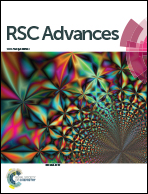DNA hybridization on silicon nanowire platform prepared by glancing angle deposition and metal assisted chemical etching process†
Abstract
A silicon nanowire platform prepared by glancing angle deposition and metal assisted chemical etching (GLAD-MACE) was used for oligonucleotides hybridization. The limit of detection of this platform was enhanced due to the large amount of probe molecules that can be accommodated on the nanowire surface and pores on the sidewall. In contrast to conventional substrates, the GLAD-MACE nanowires can accept 100 times more probes without showing probe steric hindrance. Compared to the detection of oligonucleotides with fluorescent reporters on a traditional substrate, even those facilitated by a microfluidic mixing chamber, at least a 10 times lower LoD could be reached with a passive hybridization strategy. For a device built with GLAD-MACE nanowires, it is clear that one important factor to optimize the system performance was to design an apparatus that can accelerate the diffusion process of antisense DNAs.


 Please wait while we load your content...
Please wait while we load your content...